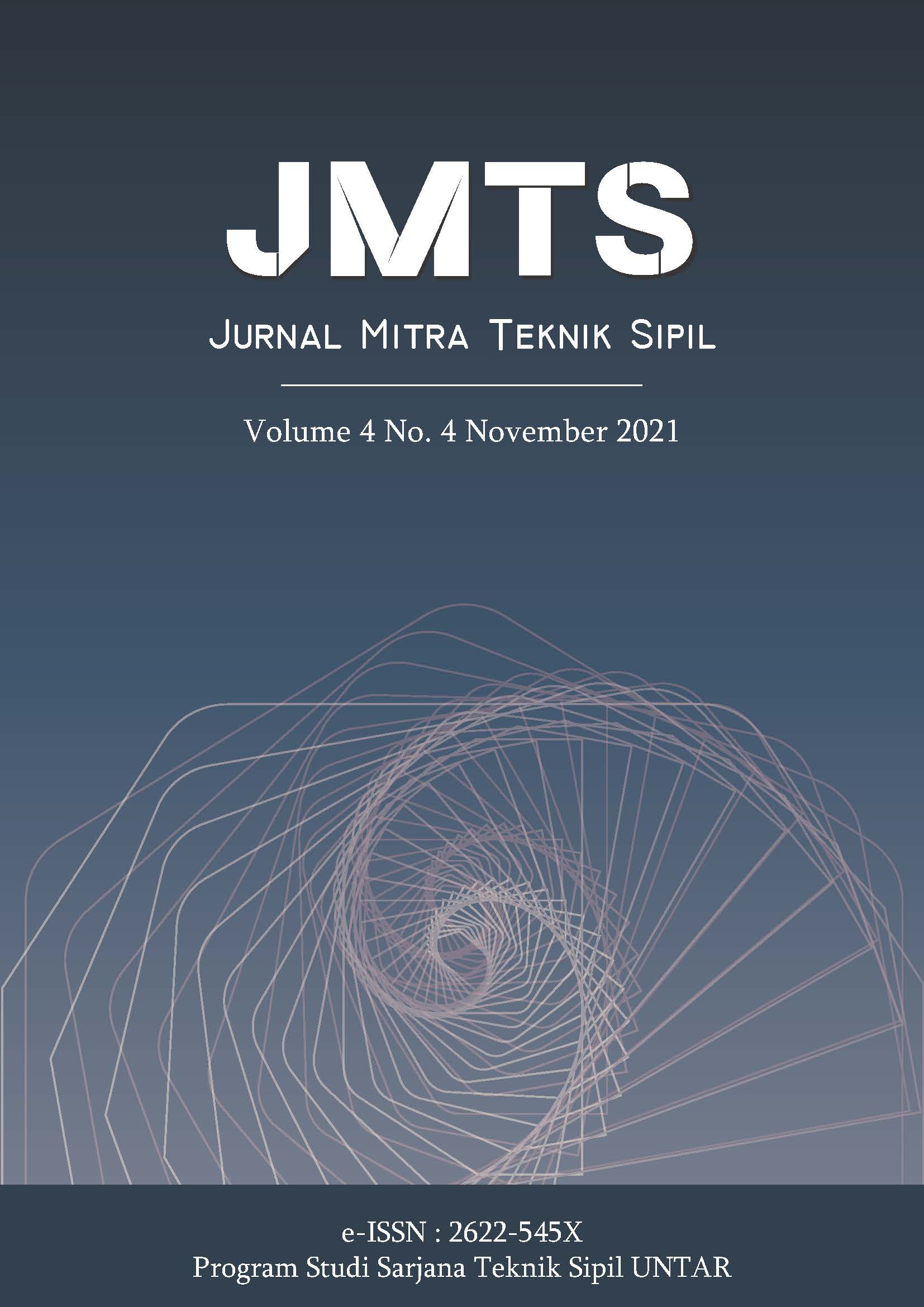ANALISIS KEMAMPUAN SELF HEALING PADA LAPIS ASPAL BETON DENGAN LIMBAH BUBUTAN BAJA SEBAGAI BAHAN TAMBAH
Main Article Content
Abstract
Steel waste is waste generated from a large or small amount of steel production process. The results of steel waste disposal can pollute the environment if not done a good treatment and countermeasure so that it has value benefits. This study uses steel lathe waste additives to determine the self-healing ability of asphalt in the AC-WC mixture. Steel lathe waste used with varying degrees of steel lathe 0%, 0,25%, 0,5%, 0,75%, 1% and asphalt content used by 5,5%. After obtaining the data used in the study, samples were made for asphalt mixtures with varying degrees. Then the finished sample is divided into 4 parts to be tested for temperature rise on each steel lathe mixture using a thermal camera. And tested using a threepoint bending test to determine the ability of asphalt selfhealing in the AC-WC mixture that occurs for 5 cycles with a heating duration of 20 seconds, 40 seconds, 60 seconds. From the results of the research on the content of a mixture of 0% steel lathe proved the sample can do self-healing but the results obtained are not as good as when using variations in the added ingredients of steel fiber mixture 0,25%, 0,5%, 0,75% and 1%.
ABSTRAK
Limbah baja adalah buangan yang dihasilkan dari suatu proses produksi baja baik dalam jumlah yang besar atau sedikit. Hasil buangan limbah baja dapat mecemari lingkungan apabila tidak dilakukan pengolahan dan penanggulangan yang baik sehingga memiliki nilai manfaat. Penelitian ini menggunakan bahan tambahan limbah bubutan baja untuk dapat mengetahui kemampuan self healing aspal pada campuran AC-WC. Limbah bubutan baja yang digunakan dengan kadar variasi bubutan baja 0%, 0,25%, 0,5%, 0,75%, 1% dan kadar aspal yang dipakai sebesar 5,5%. Setelah didapatkan data yang dipakai dalam penelitian dilakukan pembuatan sampel terhadap campuran aspal dengan variasi kadar. Kemudian sampel yang telah jadi di belah menjadi 4 bagian untuk diuji kenaikan temperatur pada setiap campuran bubutan baja dengan menggunakan kamera thermal. Serta diuji dengan menggunakan alat threepoint bending test untuk mengetahui kemampuan selfhealing aspal pada campuran AC-WC yang terjadi selama 5 siklus dengan durasi pemanasan 20 detik, 40 detik, 60 detik. Dari hasil penelitian pada kadar campuran bubutan baja 0% terbukti sampel dapat melakukan self healing tetapi hasil yang didapatkan tidak sebaik ketika menggunakan variasi bahan tambah campuran serat baja 0,25%, 0,5%, 0,75% dan 1%.
Article Details
References
Ajam, H., Gómez-Meijide, B., Artamendi, I., & Garcia, A. (2018). Mechanical and healing properties of asphalt mixes reinforced with different types of waste and commercial metal particles. Journal of Cleaner Production, 192, 138-150.
Cao, X., Wang, H., Cao, X., Sun, W., Zhu, H., & Tang, B. (2018). Investigation of rheological and chemical properties asphalt binder rejuvenated with waste vegetable oil. Construction and Building Materials, 180, 455-463.
Garc´?a, A., Norambuena-Contreras, J., Bueno, M., & Partl, M. N. (2014). Influence of Steel Wool Fibers on the Mechanical, Termal, and Healing Properties of Dense Asphalt Concrete. Journal of Testing and Evaluation, 42(5), 1107-1118.
Garcia, A., Schlangen, E., & Van de Ven, M. (2009). Two Ways of Closing Cracks on Asphalt Concrete Pavements: Microcapsules and Induction Heating. Key Engineering Materials, 573–576. doi:https://doi.org/10.4028/www.scientific.net/kem.417-418.573
González, A., Norambuena-Contreras, J., Storey, L., & Schlangen, E. (2018). Self-healing properties of recycled asphalt mixtures containing metal waste: An approach through microwave radiation heating. Journal of environmental management, 214, 242-251.
Li, H., Dong, B., Wang, W., Zhao, G., Guo, P., & Ma, Q. (2019). Effect of Waste Engine Oil and Waste Cooking Oil on Performance Improvement of Aged Asphalt. Applied Sciences, 9(9), 1767. doi:https://doi.org/10.3390/app9091767
Liu, Q., Chen, C., Li, B., Sun, Y., & Li, H. (2018). Heating characteristics and induced healing efficiencies of asphalt mixture via induction and microwave heating. Materials, 11(6), 913.
Pemerintah Republik Indonesia. (1999). PERATURAN PEMERINTAH REPUBLIK INDONESIA NOMOR 18 TAHUN 1999 TENTANG PENGELOLAAN LIMBAH BAHAN BERBAHAYA DAN BERACUN. Jakarta: Pemerintah Republik Indonesia.
Pérez, I., Agzenai, Y., Pozuelo, J., Sanz, J., Baselga, J., García, A., & Pérez, V. (2016). Self-healing of asphalt mixes, containing conductive modified bitumen, using microwave heating. Proceedings of the 6th Eurasphalt & Eurobitume Congress, (pp. 1-3). Prague.
Sun, Y. H., Liu, Q. T., Wu, S. P., & Shang, F. (2014). Microwave heating of steel slag asphalt mixture. Key Engineering Materials, 599, 193-197.
Tajudin, A. N., & Suparma, L. B. (2017). Pengaruh Rendaman pada Indirect Tensile Strength Campuran AC-BC dengan Limbah Plastik sebagai Agregat Pengganti. MEDIA KOMUNIKASI TEKNIK SIPIL, 23(2), 166-173. doi:https://doi.org/10.14710/mkts.v23i2.16128
White, S. R., Sottos, N. R., Guebelle, P. H., Moore, J. S., Kessler, M. R., Sriram, S. R., . . . Viswanathan, S. (2001). Autonomic healing of polymer composites. Nature, 409(6822), 794-797



